Comprehensive Report on Salmonellosis and Food Safety Measures
VerifiedAdded on 2020/05/04
|14
|4524
|214
Report
AI Summary
This report comprehensively addresses Salmonellosis, a bacterial infection causing food poisoning, emphasizing its prevalence in poultry, eggs, fish, and milk products. It underscores the importance of risk assessment at every stage of product development, from proposal and design to production and shelf life, to prevent contamination. The report details hazard identification, including the avoidance of cold or raw foods, and the significance of hygienic practices. It outlines the minimum bacterial dose required for infection, the symptoms, and the likelihood of adverse outcomes, stressing the need for consumer education and proactive measures to ensure food safety. The report also covers risk characterization, including health issues, and the role of hygiene in preventing the spread of the bacteria, while also providing detailed information regarding the shelf life stage and exposure diagnosis.
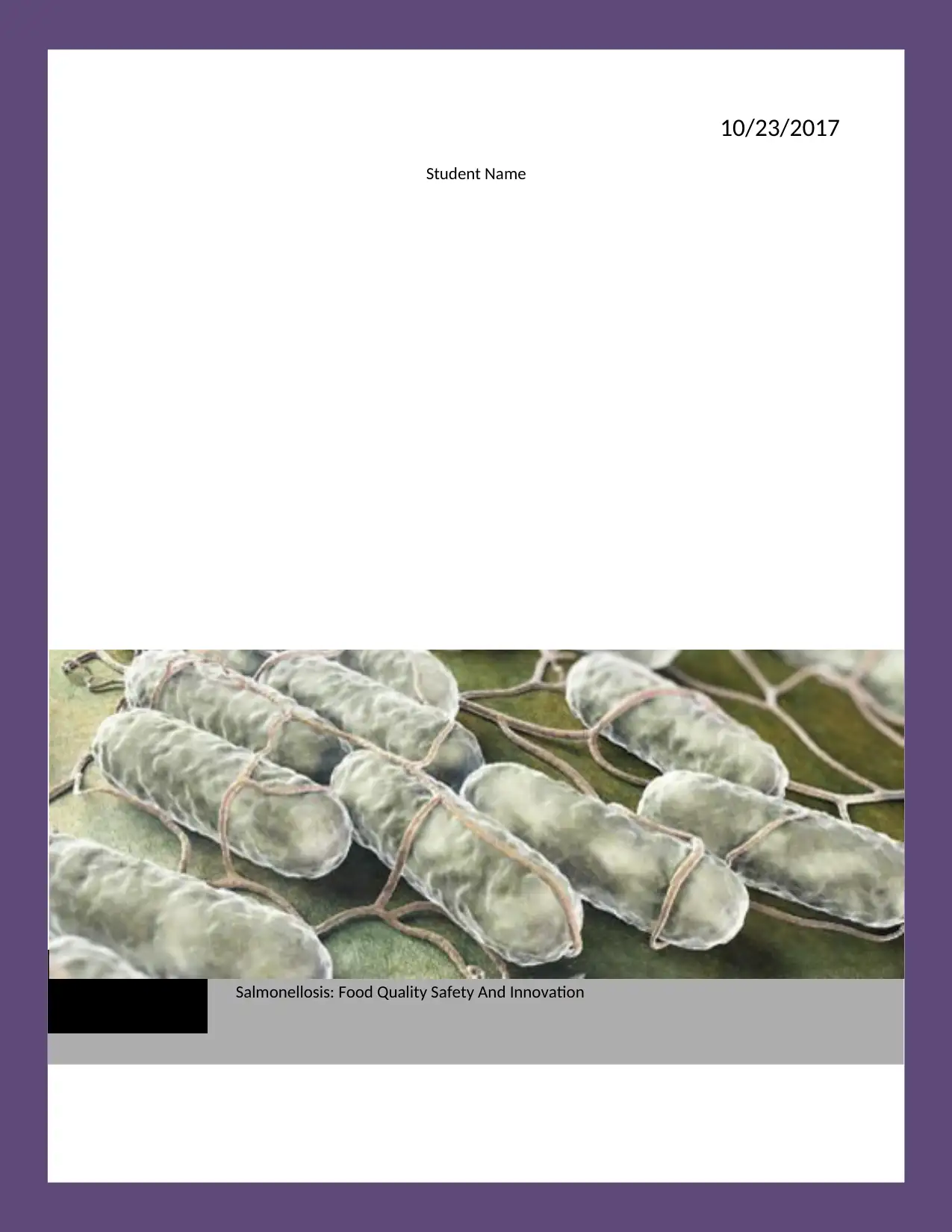
10/23/2017
Student Name
Salmonellosis: Food Quality Safety And Innovation
Student Name
Salmonellosis: Food Quality Safety And Innovation
Paraphrase This Document
Need a fresh take? Get an instant paraphrase of this document with our AI Paraphraser
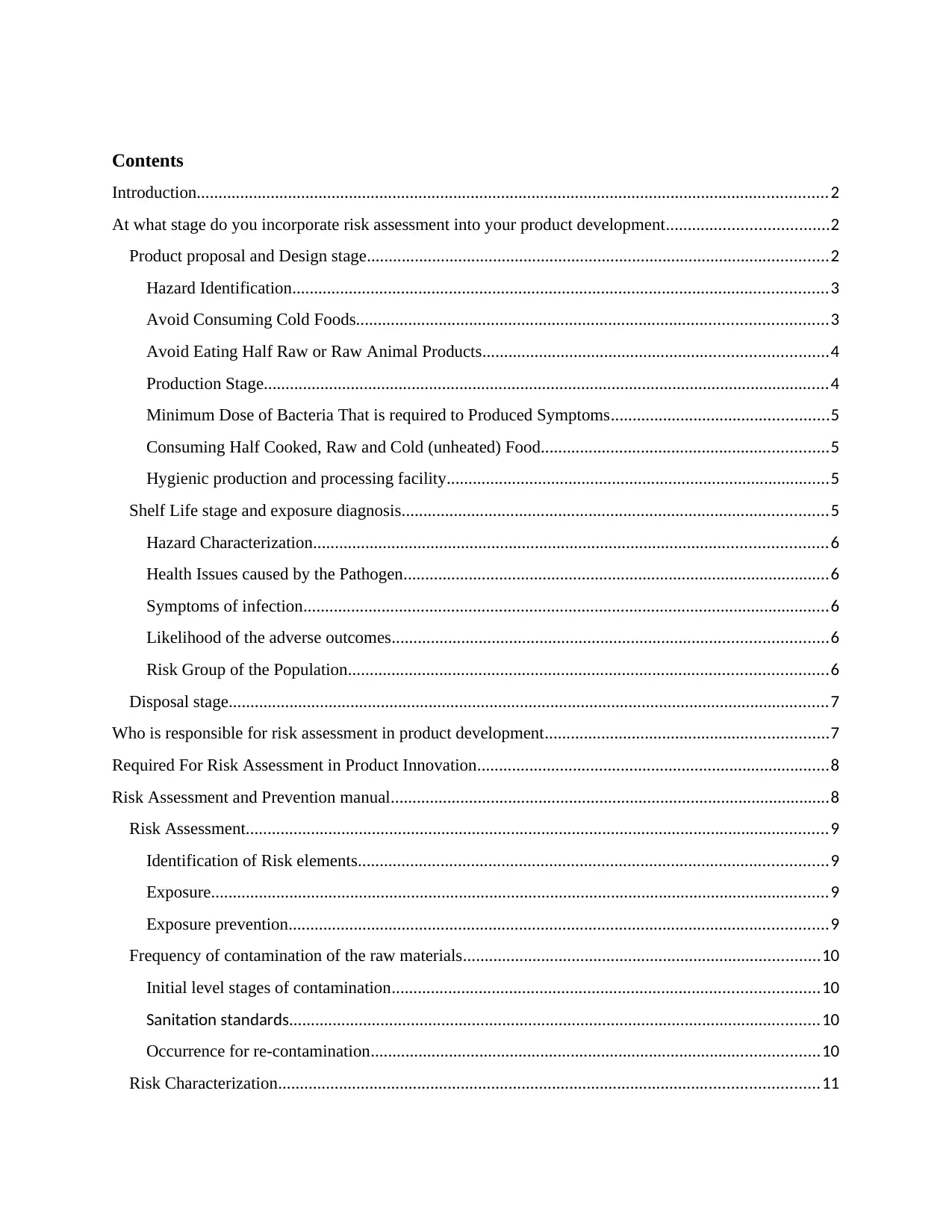
Contents
Introduction.................................................................................................................................................2
At what stage do you incorporate risk assessment into your product development.....................................2
Product proposal and Design stage..........................................................................................................2
Hazard Identification...........................................................................................................................3
Avoid Consuming Cold Foods............................................................................................................3
Avoid Eating Half Raw or Raw Animal Products...............................................................................4
Production Stage..................................................................................................................................4
Minimum Dose of Bacteria That is required to Produced Symptoms..................................................5
Consuming Half Cooked, Raw and Cold (unheated) Food..................................................................5
Hygienic production and processing facility........................................................................................5
Shelf Life stage and exposure diagnosis..................................................................................................5
Hazard Characterization......................................................................................................................6
Health Issues caused by the Pathogen..................................................................................................6
Symptoms of infection.........................................................................................................................6
Likelihood of the adverse outcomes....................................................................................................6
Risk Group of the Population..............................................................................................................6
Disposal stage..........................................................................................................................................7
Who is responsible for risk assessment in product development.................................................................7
Required For Risk Assessment in Product Innovation.................................................................................8
Risk Assessment and Prevention manual.....................................................................................................8
Risk Assessment......................................................................................................................................9
Identification of Risk elements............................................................................................................9
Exposure..............................................................................................................................................9
Exposure prevention............................................................................................................................9
Frequency of contamination of the raw materials..................................................................................10
Initial level stages of contamination..................................................................................................10
Sanitation standards..........................................................................................................................10
Occurrence for re-contamination.......................................................................................................10
Risk Characterization............................................................................................................................11
Introduction.................................................................................................................................................2
At what stage do you incorporate risk assessment into your product development.....................................2
Product proposal and Design stage..........................................................................................................2
Hazard Identification...........................................................................................................................3
Avoid Consuming Cold Foods............................................................................................................3
Avoid Eating Half Raw or Raw Animal Products...............................................................................4
Production Stage..................................................................................................................................4
Minimum Dose of Bacteria That is required to Produced Symptoms..................................................5
Consuming Half Cooked, Raw and Cold (unheated) Food..................................................................5
Hygienic production and processing facility........................................................................................5
Shelf Life stage and exposure diagnosis..................................................................................................5
Hazard Characterization......................................................................................................................6
Health Issues caused by the Pathogen..................................................................................................6
Symptoms of infection.........................................................................................................................6
Likelihood of the adverse outcomes....................................................................................................6
Risk Group of the Population..............................................................................................................6
Disposal stage..........................................................................................................................................7
Who is responsible for risk assessment in product development.................................................................7
Required For Risk Assessment in Product Innovation.................................................................................8
Risk Assessment and Prevention manual.....................................................................................................8
Risk Assessment......................................................................................................................................9
Identification of Risk elements............................................................................................................9
Exposure..............................................................................................................................................9
Exposure prevention............................................................................................................................9
Frequency of contamination of the raw materials..................................................................................10
Initial level stages of contamination..................................................................................................10
Sanitation standards..........................................................................................................................10
Occurrence for re-contamination.......................................................................................................10
Risk Characterization............................................................................................................................11
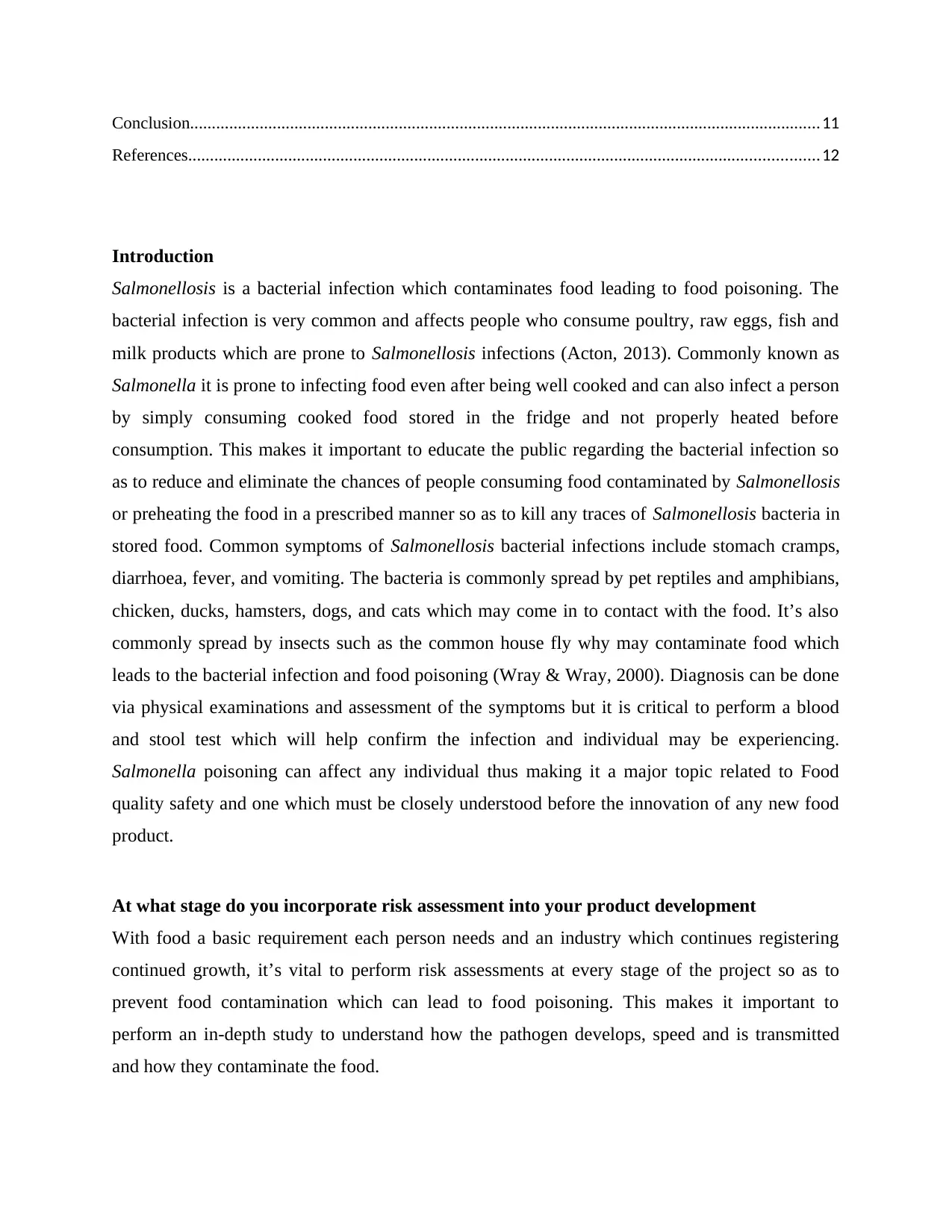
Conclusion.................................................................................................................................................11
References.................................................................................................................................................12
Introduction
Salmonellosis is a bacterial infection which contaminates food leading to food poisoning. The
bacterial infection is very common and affects people who consume poultry, raw eggs, fish and
milk products which are prone to Salmonellosis infections (Acton, 2013). Commonly known as
Salmonella it is prone to infecting food even after being well cooked and can also infect a person
by simply consuming cooked food stored in the fridge and not properly heated before
consumption. This makes it important to educate the public regarding the bacterial infection so
as to reduce and eliminate the chances of people consuming food contaminated by Salmonellosis
or preheating the food in a prescribed manner so as to kill any traces of Salmonellosis bacteria in
stored food. Common symptoms of Salmonellosis bacterial infections include stomach cramps,
diarrhoea, fever, and vomiting. The bacteria is commonly spread by pet reptiles and amphibians,
chicken, ducks, hamsters, dogs, and cats which may come in to contact with the food. It’s also
commonly spread by insects such as the common house fly why may contaminate food which
leads to the bacterial infection and food poisoning (Wray & Wray, 2000). Diagnosis can be done
via physical examinations and assessment of the symptoms but it is critical to perform a blood
and stool test which will help confirm the infection and individual may be experiencing.
Salmonella poisoning can affect any individual thus making it a major topic related to Food
quality safety and one which must be closely understood before the innovation of any new food
product.
At what stage do you incorporate risk assessment into your product development
With food a basic requirement each person needs and an industry which continues registering
continued growth, it’s vital to perform risk assessments at every stage of the project so as to
prevent food contamination which can lead to food poisoning. This makes it important to
perform an in-depth study to understand how the pathogen develops, speed and is transmitted
and how they contaminate the food.
References.................................................................................................................................................12
Introduction
Salmonellosis is a bacterial infection which contaminates food leading to food poisoning. The
bacterial infection is very common and affects people who consume poultry, raw eggs, fish and
milk products which are prone to Salmonellosis infections (Acton, 2013). Commonly known as
Salmonella it is prone to infecting food even after being well cooked and can also infect a person
by simply consuming cooked food stored in the fridge and not properly heated before
consumption. This makes it important to educate the public regarding the bacterial infection so
as to reduce and eliminate the chances of people consuming food contaminated by Salmonellosis
or preheating the food in a prescribed manner so as to kill any traces of Salmonellosis bacteria in
stored food. Common symptoms of Salmonellosis bacterial infections include stomach cramps,
diarrhoea, fever, and vomiting. The bacteria is commonly spread by pet reptiles and amphibians,
chicken, ducks, hamsters, dogs, and cats which may come in to contact with the food. It’s also
commonly spread by insects such as the common house fly why may contaminate food which
leads to the bacterial infection and food poisoning (Wray & Wray, 2000). Diagnosis can be done
via physical examinations and assessment of the symptoms but it is critical to perform a blood
and stool test which will help confirm the infection and individual may be experiencing.
Salmonella poisoning can affect any individual thus making it a major topic related to Food
quality safety and one which must be closely understood before the innovation of any new food
product.
At what stage do you incorporate risk assessment into your product development
With food a basic requirement each person needs and an industry which continues registering
continued growth, it’s vital to perform risk assessments at every stage of the project so as to
prevent food contamination which can lead to food poisoning. This makes it important to
perform an in-depth study to understand how the pathogen develops, speed and is transmitted
and how they contaminate the food.
⊘ This is a preview!⊘
Do you want full access?
Subscribe today to unlock all pages.

Trusted by 1+ million students worldwide
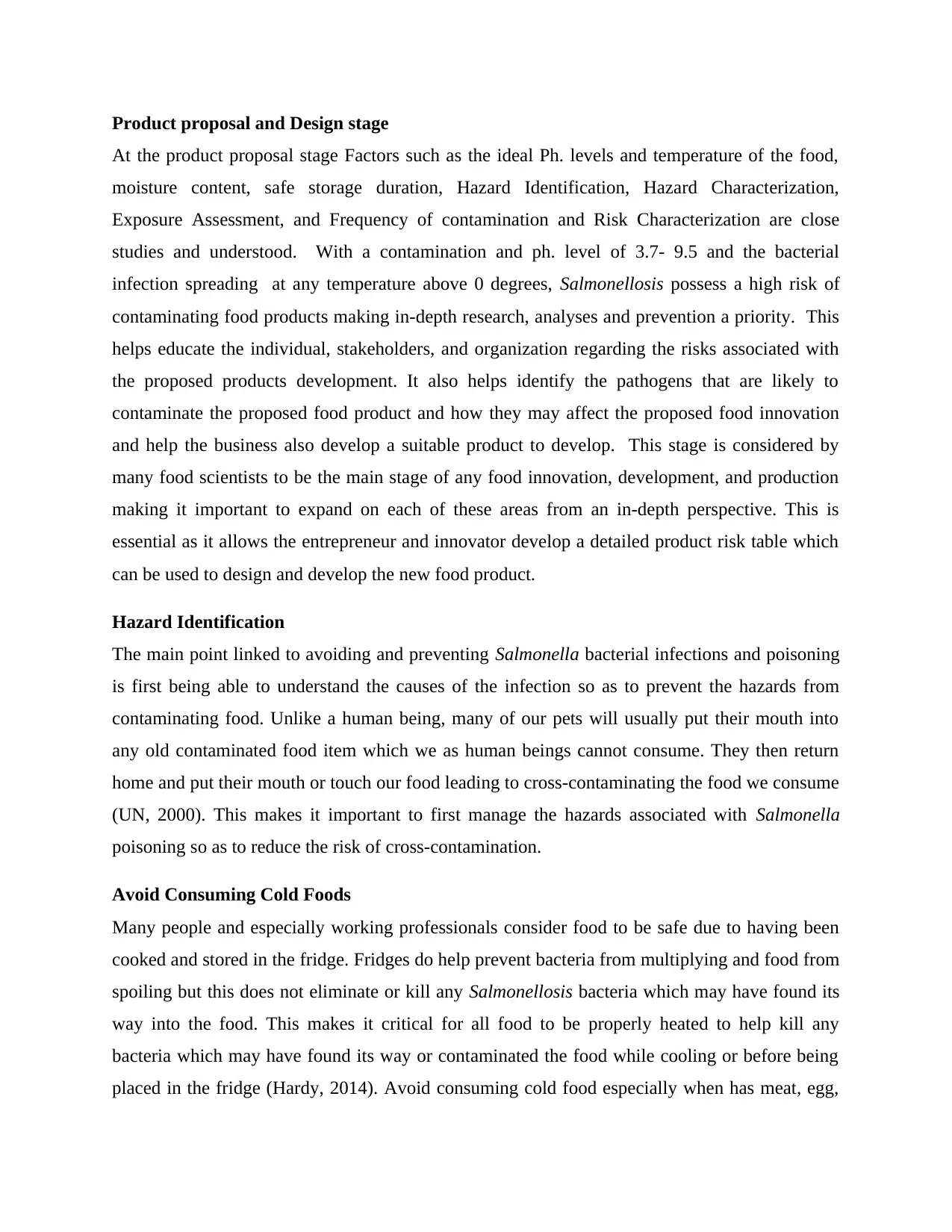
Product proposal and Design stage
At the product proposal stage Factors such as the ideal Ph. levels and temperature of the food,
moisture content, safe storage duration, Hazard Identification, Hazard Characterization,
Exposure Assessment, and Frequency of contamination and Risk Characterization are close
studies and understood. With a contamination and ph. level of 3.7- 9.5 and the bacterial
infection spreading at any temperature above 0 degrees, Salmonellosis possess a high risk of
contaminating food products making in-depth research, analyses and prevention a priority. This
helps educate the individual, stakeholders, and organization regarding the risks associated with
the proposed products development. It also helps identify the pathogens that are likely to
contaminate the proposed food product and how they may affect the proposed food innovation
and help the business also develop a suitable product to develop. This stage is considered by
many food scientists to be the main stage of any food innovation, development, and production
making it important to expand on each of these areas from an in-depth perspective. This is
essential as it allows the entrepreneur and innovator develop a detailed product risk table which
can be used to design and develop the new food product.
Hazard Identification
The main point linked to avoiding and preventing Salmonella bacterial infections and poisoning
is first being able to understand the causes of the infection so as to prevent the hazards from
contaminating food. Unlike a human being, many of our pets will usually put their mouth into
any old contaminated food item which we as human beings cannot consume. They then return
home and put their mouth or touch our food leading to cross-contaminating the food we consume
(UN, 2000). This makes it important to first manage the hazards associated with Salmonella
poisoning so as to reduce the risk of cross-contamination.
Avoid Consuming Cold Foods
Many people and especially working professionals consider food to be safe due to having been
cooked and stored in the fridge. Fridges do help prevent bacteria from multiplying and food from
spoiling but this does not eliminate or kill any Salmonellosis bacteria which may have found its
way into the food. This makes it critical for all food to be properly heated to help kill any
bacteria which may have found its way or contaminated the food while cooling or before being
placed in the fridge (Hardy, 2014). Avoid consuming cold food especially when has meat, egg,
At the product proposal stage Factors such as the ideal Ph. levels and temperature of the food,
moisture content, safe storage duration, Hazard Identification, Hazard Characterization,
Exposure Assessment, and Frequency of contamination and Risk Characterization are close
studies and understood. With a contamination and ph. level of 3.7- 9.5 and the bacterial
infection spreading at any temperature above 0 degrees, Salmonellosis possess a high risk of
contaminating food products making in-depth research, analyses and prevention a priority. This
helps educate the individual, stakeholders, and organization regarding the risks associated with
the proposed products development. It also helps identify the pathogens that are likely to
contaminate the proposed food product and how they may affect the proposed food innovation
and help the business also develop a suitable product to develop. This stage is considered by
many food scientists to be the main stage of any food innovation, development, and production
making it important to expand on each of these areas from an in-depth perspective. This is
essential as it allows the entrepreneur and innovator develop a detailed product risk table which
can be used to design and develop the new food product.
Hazard Identification
The main point linked to avoiding and preventing Salmonella bacterial infections and poisoning
is first being able to understand the causes of the infection so as to prevent the hazards from
contaminating food. Unlike a human being, many of our pets will usually put their mouth into
any old contaminated food item which we as human beings cannot consume. They then return
home and put their mouth or touch our food leading to cross-contaminating the food we consume
(UN, 2000). This makes it important to first manage the hazards associated with Salmonella
poisoning so as to reduce the risk of cross-contamination.
Avoid Consuming Cold Foods
Many people and especially working professionals consider food to be safe due to having been
cooked and stored in the fridge. Fridges do help prevent bacteria from multiplying and food from
spoiling but this does not eliminate or kill any Salmonellosis bacteria which may have found its
way into the food. This makes it critical for all food to be properly heated to help kill any
bacteria which may have found its way or contaminated the food while cooling or before being
placed in the fridge (Hardy, 2014). Avoid consuming cold food especially when has meat, egg,
Paraphrase This Document
Need a fresh take? Get an instant paraphrase of this document with our AI Paraphraser
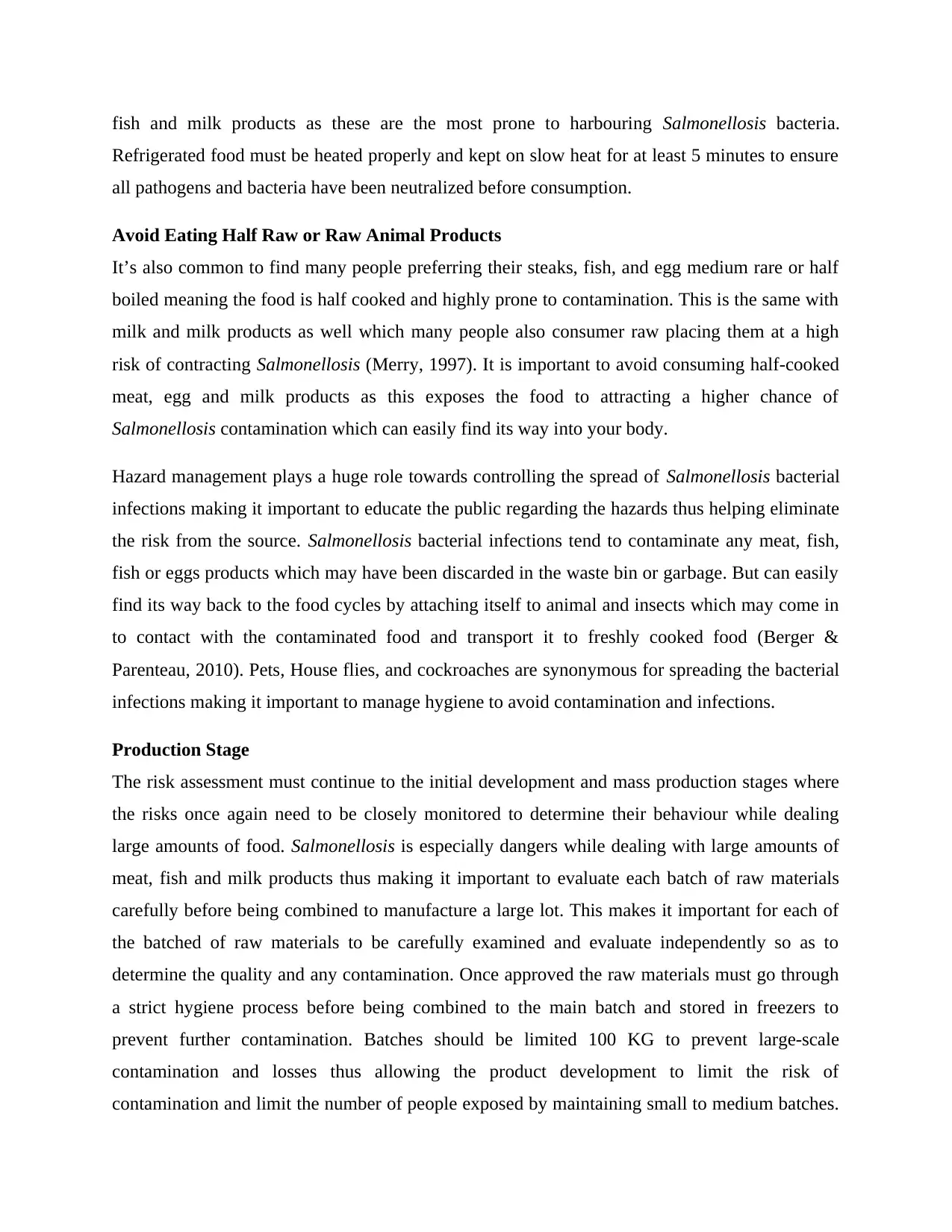
fish and milk products as these are the most prone to harbouring Salmonellosis bacteria.
Refrigerated food must be heated properly and kept on slow heat for at least 5 minutes to ensure
all pathogens and bacteria have been neutralized before consumption.
Avoid Eating Half Raw or Raw Animal Products
It’s also common to find many people preferring their steaks, fish, and egg medium rare or half
boiled meaning the food is half cooked and highly prone to contamination. This is the same with
milk and milk products as well which many people also consumer raw placing them at a high
risk of contracting Salmonellosis (Merry, 1997). It is important to avoid consuming half-cooked
meat, egg and milk products as this exposes the food to attracting a higher chance of
Salmonellosis contamination which can easily find its way into your body.
Hazard management plays a huge role towards controlling the spread of Salmonellosis bacterial
infections making it important to educate the public regarding the hazards thus helping eliminate
the risk from the source. Salmonellosis bacterial infections tend to contaminate any meat, fish,
fish or eggs products which may have been discarded in the waste bin or garbage. But can easily
find its way back to the food cycles by attaching itself to animal and insects which may come in
to contact with the contaminated food and transport it to freshly cooked food (Berger &
Parenteau, 2010). Pets, House flies, and cockroaches are synonymous for spreading the bacterial
infections making it important to manage hygiene to avoid contamination and infections.
Production Stage
The risk assessment must continue to the initial development and mass production stages where
the risks once again need to be closely monitored to determine their behaviour while dealing
large amounts of food. Salmonellosis is especially dangers while dealing with large amounts of
meat, fish and milk products thus making it important to evaluate each batch of raw materials
carefully before being combined to manufacture a large lot. This makes it important for each of
the batched of raw materials to be carefully examined and evaluate independently so as to
determine the quality and any contamination. Once approved the raw materials must go through
a strict hygiene process before being combined to the main batch and stored in freezers to
prevent further contamination. Batches should be limited 100 KG to prevent large-scale
contamination and losses thus allowing the product development to limit the risk of
contamination and limit the number of people exposed by maintaining small to medium batches.
Refrigerated food must be heated properly and kept on slow heat for at least 5 minutes to ensure
all pathogens and bacteria have been neutralized before consumption.
Avoid Eating Half Raw or Raw Animal Products
It’s also common to find many people preferring their steaks, fish, and egg medium rare or half
boiled meaning the food is half cooked and highly prone to contamination. This is the same with
milk and milk products as well which many people also consumer raw placing them at a high
risk of contracting Salmonellosis (Merry, 1997). It is important to avoid consuming half-cooked
meat, egg and milk products as this exposes the food to attracting a higher chance of
Salmonellosis contamination which can easily find its way into your body.
Hazard management plays a huge role towards controlling the spread of Salmonellosis bacterial
infections making it important to educate the public regarding the hazards thus helping eliminate
the risk from the source. Salmonellosis bacterial infections tend to contaminate any meat, fish,
fish or eggs products which may have been discarded in the waste bin or garbage. But can easily
find its way back to the food cycles by attaching itself to animal and insects which may come in
to contact with the contaminated food and transport it to freshly cooked food (Berger &
Parenteau, 2010). Pets, House flies, and cockroaches are synonymous for spreading the bacterial
infections making it important to manage hygiene to avoid contamination and infections.
Production Stage
The risk assessment must continue to the initial development and mass production stages where
the risks once again need to be closely monitored to determine their behaviour while dealing
large amounts of food. Salmonellosis is especially dangers while dealing with large amounts of
meat, fish and milk products thus making it important to evaluate each batch of raw materials
carefully before being combined to manufacture a large lot. This makes it important for each of
the batched of raw materials to be carefully examined and evaluate independently so as to
determine the quality and any contamination. Once approved the raw materials must go through
a strict hygiene process before being combined to the main batch and stored in freezers to
prevent further contamination. Batches should be limited 100 KG to prevent large-scale
contamination and losses thus allowing the product development to limit the risk of
contamination and limit the number of people exposed by maintaining small to medium batches.
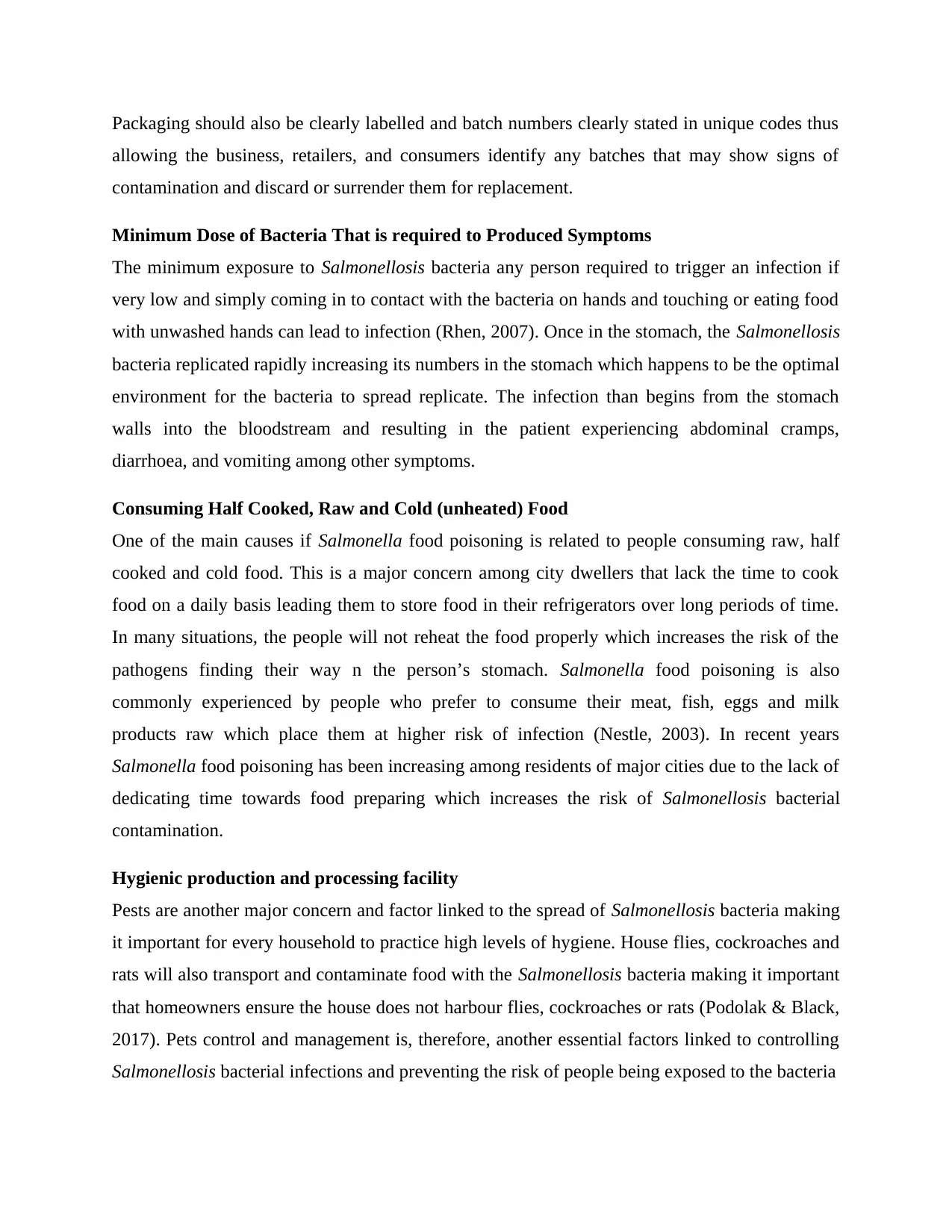
Packaging should also be clearly labelled and batch numbers clearly stated in unique codes thus
allowing the business, retailers, and consumers identify any batches that may show signs of
contamination and discard or surrender them for replacement.
Minimum Dose of Bacteria That is required to Produced Symptoms
The minimum exposure to Salmonellosis bacteria any person required to trigger an infection if
very low and simply coming in to contact with the bacteria on hands and touching or eating food
with unwashed hands can lead to infection (Rhen, 2007). Once in the stomach, the Salmonellosis
bacteria replicated rapidly increasing its numbers in the stomach which happens to be the optimal
environment for the bacteria to spread replicate. The infection than begins from the stomach
walls into the bloodstream and resulting in the patient experiencing abdominal cramps,
diarrhoea, and vomiting among other symptoms.
Consuming Half Cooked, Raw and Cold (unheated) Food
One of the main causes if Salmonella food poisoning is related to people consuming raw, half
cooked and cold food. This is a major concern among city dwellers that lack the time to cook
food on a daily basis leading them to store food in their refrigerators over long periods of time.
In many situations, the people will not reheat the food properly which increases the risk of the
pathogens finding their way n the person’s stomach. Salmonella food poisoning is also
commonly experienced by people who prefer to consume their meat, fish, eggs and milk
products raw which place them at higher risk of infection (Nestle, 2003). In recent years
Salmonella food poisoning has been increasing among residents of major cities due to the lack of
dedicating time towards food preparing which increases the risk of Salmonellosis bacterial
contamination.
Hygienic production and processing facility
Pests are another major concern and factor linked to the spread of Salmonellosis bacteria making
it important for every household to practice high levels of hygiene. House flies, cockroaches and
rats will also transport and contaminate food with the Salmonellosis bacteria making it important
that homeowners ensure the house does not harbour flies, cockroaches or rats (Podolak & Black,
2017). Pets control and management is, therefore, another essential factors linked to controlling
Salmonellosis bacterial infections and preventing the risk of people being exposed to the bacteria
allowing the business, retailers, and consumers identify any batches that may show signs of
contamination and discard or surrender them for replacement.
Minimum Dose of Bacteria That is required to Produced Symptoms
The minimum exposure to Salmonellosis bacteria any person required to trigger an infection if
very low and simply coming in to contact with the bacteria on hands and touching or eating food
with unwashed hands can lead to infection (Rhen, 2007). Once in the stomach, the Salmonellosis
bacteria replicated rapidly increasing its numbers in the stomach which happens to be the optimal
environment for the bacteria to spread replicate. The infection than begins from the stomach
walls into the bloodstream and resulting in the patient experiencing abdominal cramps,
diarrhoea, and vomiting among other symptoms.
Consuming Half Cooked, Raw and Cold (unheated) Food
One of the main causes if Salmonella food poisoning is related to people consuming raw, half
cooked and cold food. This is a major concern among city dwellers that lack the time to cook
food on a daily basis leading them to store food in their refrigerators over long periods of time.
In many situations, the people will not reheat the food properly which increases the risk of the
pathogens finding their way n the person’s stomach. Salmonella food poisoning is also
commonly experienced by people who prefer to consume their meat, fish, eggs and milk
products raw which place them at higher risk of infection (Nestle, 2003). In recent years
Salmonella food poisoning has been increasing among residents of major cities due to the lack of
dedicating time towards food preparing which increases the risk of Salmonellosis bacterial
contamination.
Hygienic production and processing facility
Pests are another major concern and factor linked to the spread of Salmonellosis bacteria making
it important for every household to practice high levels of hygiene. House flies, cockroaches and
rats will also transport and contaminate food with the Salmonellosis bacteria making it important
that homeowners ensure the house does not harbour flies, cockroaches or rats (Podolak & Black,
2017). Pets control and management is, therefore, another essential factors linked to controlling
Salmonellosis bacterial infections and preventing the risk of people being exposed to the bacteria
⊘ This is a preview!⊘
Do you want full access?
Subscribe today to unlock all pages.

Trusted by 1+ million students worldwide
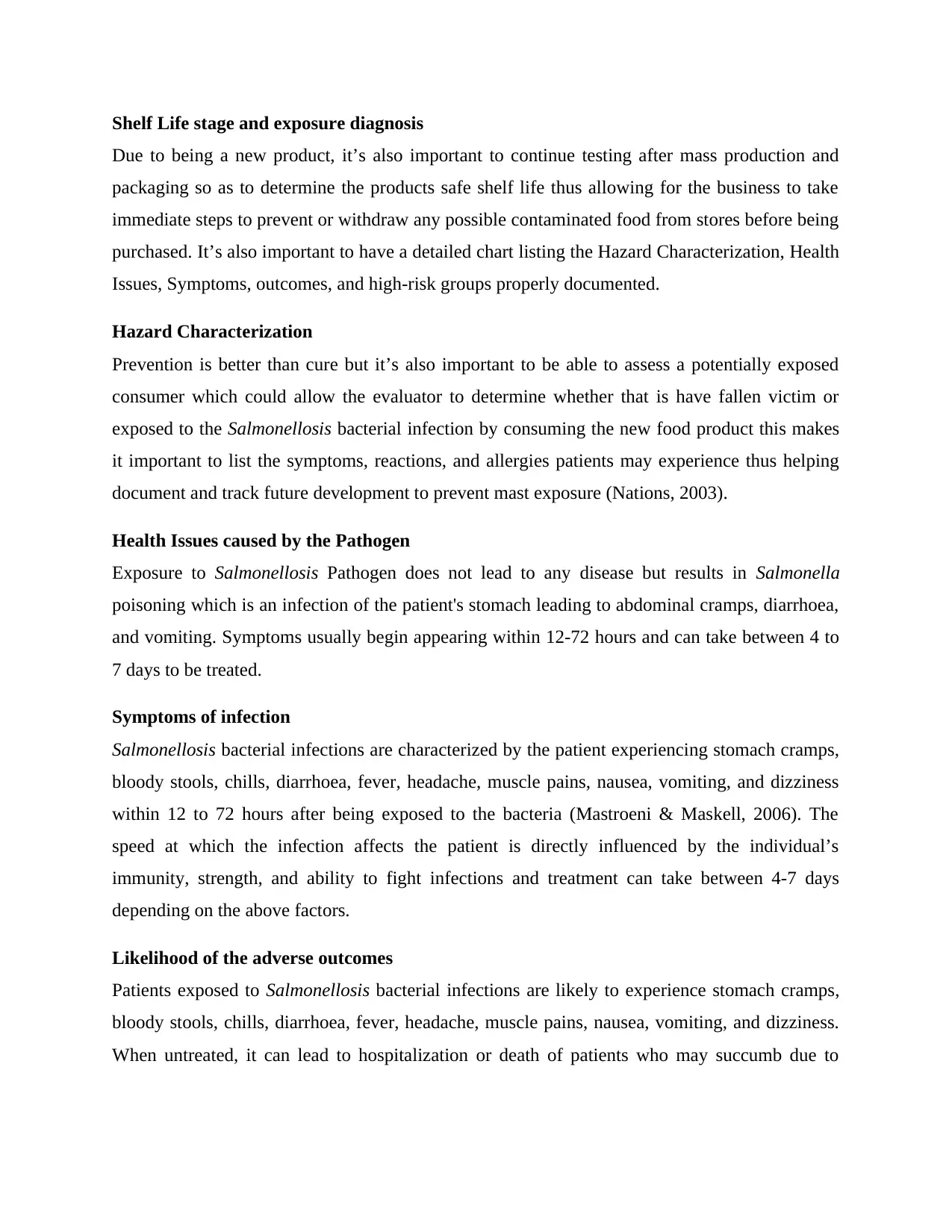
Shelf Life stage and exposure diagnosis
Due to being a new product, it’s also important to continue testing after mass production and
packaging so as to determine the products safe shelf life thus allowing for the business to take
immediate steps to prevent or withdraw any possible contaminated food from stores before being
purchased. It’s also important to have a detailed chart listing the Hazard Characterization, Health
Issues, Symptoms, outcomes, and high-risk groups properly documented.
Hazard Characterization
Prevention is better than cure but it’s also important to be able to assess a potentially exposed
consumer which could allow the evaluator to determine whether that is have fallen victim or
exposed to the Salmonellosis bacterial infection by consuming the new food product this makes
it important to list the symptoms, reactions, and allergies patients may experience thus helping
document and track future development to prevent mast exposure (Nations, 2003).
Health Issues caused by the Pathogen
Exposure to Salmonellosis Pathogen does not lead to any disease but results in Salmonella
poisoning which is an infection of the patient's stomach leading to abdominal cramps, diarrhoea,
and vomiting. Symptoms usually begin appearing within 12-72 hours and can take between 4 to
7 days to be treated.
Symptoms of infection
Salmonellosis bacterial infections are characterized by the patient experiencing stomach cramps,
bloody stools, chills, diarrhoea, fever, headache, muscle pains, nausea, vomiting, and dizziness
within 12 to 72 hours after being exposed to the bacteria (Mastroeni & Maskell, 2006). The
speed at which the infection affects the patient is directly influenced by the individual’s
immunity, strength, and ability to fight infections and treatment can take between 4-7 days
depending on the above factors.
Likelihood of the adverse outcomes
Patients exposed to Salmonellosis bacterial infections are likely to experience stomach cramps,
bloody stools, chills, diarrhoea, fever, headache, muscle pains, nausea, vomiting, and dizziness.
When untreated, it can lead to hospitalization or death of patients who may succumb due to
Due to being a new product, it’s also important to continue testing after mass production and
packaging so as to determine the products safe shelf life thus allowing for the business to take
immediate steps to prevent or withdraw any possible contaminated food from stores before being
purchased. It’s also important to have a detailed chart listing the Hazard Characterization, Health
Issues, Symptoms, outcomes, and high-risk groups properly documented.
Hazard Characterization
Prevention is better than cure but it’s also important to be able to assess a potentially exposed
consumer which could allow the evaluator to determine whether that is have fallen victim or
exposed to the Salmonellosis bacterial infection by consuming the new food product this makes
it important to list the symptoms, reactions, and allergies patients may experience thus helping
document and track future development to prevent mast exposure (Nations, 2003).
Health Issues caused by the Pathogen
Exposure to Salmonellosis Pathogen does not lead to any disease but results in Salmonella
poisoning which is an infection of the patient's stomach leading to abdominal cramps, diarrhoea,
and vomiting. Symptoms usually begin appearing within 12-72 hours and can take between 4 to
7 days to be treated.
Symptoms of infection
Salmonellosis bacterial infections are characterized by the patient experiencing stomach cramps,
bloody stools, chills, diarrhoea, fever, headache, muscle pains, nausea, vomiting, and dizziness
within 12 to 72 hours after being exposed to the bacteria (Mastroeni & Maskell, 2006). The
speed at which the infection affects the patient is directly influenced by the individual’s
immunity, strength, and ability to fight infections and treatment can take between 4-7 days
depending on the above factors.
Likelihood of the adverse outcomes
Patients exposed to Salmonellosis bacterial infections are likely to experience stomach cramps,
bloody stools, chills, diarrhoea, fever, headache, muscle pains, nausea, vomiting, and dizziness.
When untreated, it can lead to hospitalization or death of patients who may succumb due to
Paraphrase This Document
Need a fresh take? Get an instant paraphrase of this document with our AI Paraphraser
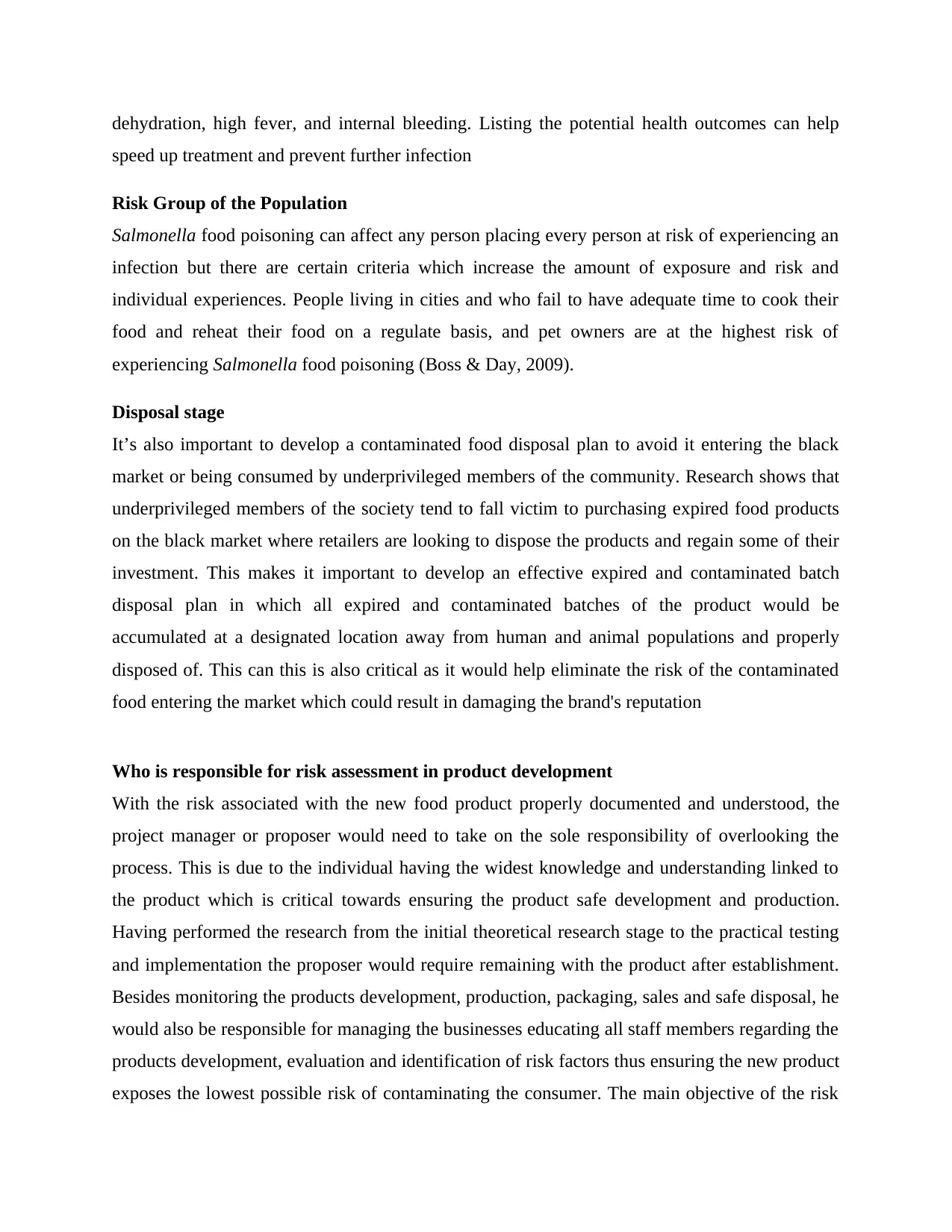
dehydration, high fever, and internal bleeding. Listing the potential health outcomes can help
speed up treatment and prevent further infection
Risk Group of the Population
Salmonella food poisoning can affect any person placing every person at risk of experiencing an
infection but there are certain criteria which increase the amount of exposure and risk and
individual experiences. People living in cities and who fail to have adequate time to cook their
food and reheat their food on a regulate basis, and pet owners are at the highest risk of
experiencing Salmonella food poisoning (Boss & Day, 2009).
Disposal stage
It’s also important to develop a contaminated food disposal plan to avoid it entering the black
market or being consumed by underprivileged members of the community. Research shows that
underprivileged members of the society tend to fall victim to purchasing expired food products
on the black market where retailers are looking to dispose the products and regain some of their
investment. This makes it important to develop an effective expired and contaminated batch
disposal plan in which all expired and contaminated batches of the product would be
accumulated at a designated location away from human and animal populations and properly
disposed of. This can this is also critical as it would help eliminate the risk of the contaminated
food entering the market which could result in damaging the brand's reputation
Who is responsible for risk assessment in product development
With the risk associated with the new food product properly documented and understood, the
project manager or proposer would need to take on the sole responsibility of overlooking the
process. This is due to the individual having the widest knowledge and understanding linked to
the product which is critical towards ensuring the product safe development and production.
Having performed the research from the initial theoretical research stage to the practical testing
and implementation the proposer would require remaining with the product after establishment.
Besides monitoring the products development, production, packaging, sales and safe disposal, he
would also be responsible for managing the businesses educating all staff members regarding the
products development, evaluation and identification of risk factors thus ensuring the new product
exposes the lowest possible risk of contaminating the consumer. The main objective of the risk
speed up treatment and prevent further infection
Risk Group of the Population
Salmonella food poisoning can affect any person placing every person at risk of experiencing an
infection but there are certain criteria which increase the amount of exposure and risk and
individual experiences. People living in cities and who fail to have adequate time to cook their
food and reheat their food on a regulate basis, and pet owners are at the highest risk of
experiencing Salmonella food poisoning (Boss & Day, 2009).
Disposal stage
It’s also important to develop a contaminated food disposal plan to avoid it entering the black
market or being consumed by underprivileged members of the community. Research shows that
underprivileged members of the society tend to fall victim to purchasing expired food products
on the black market where retailers are looking to dispose the products and regain some of their
investment. This makes it important to develop an effective expired and contaminated batch
disposal plan in which all expired and contaminated batches of the product would be
accumulated at a designated location away from human and animal populations and properly
disposed of. This can this is also critical as it would help eliminate the risk of the contaminated
food entering the market which could result in damaging the brand's reputation
Who is responsible for risk assessment in product development
With the risk associated with the new food product properly documented and understood, the
project manager or proposer would need to take on the sole responsibility of overlooking the
process. This is due to the individual having the widest knowledge and understanding linked to
the product which is critical towards ensuring the product safe development and production.
Having performed the research from the initial theoretical research stage to the practical testing
and implementation the proposer would require remaining with the product after establishment.
Besides monitoring the products development, production, packaging, sales and safe disposal, he
would also be responsible for managing the businesses educating all staff members regarding the
products development, evaluation and identification of risk factors thus ensuring the new product
exposes the lowest possible risk of contaminating the consumer. The main objective of the risk
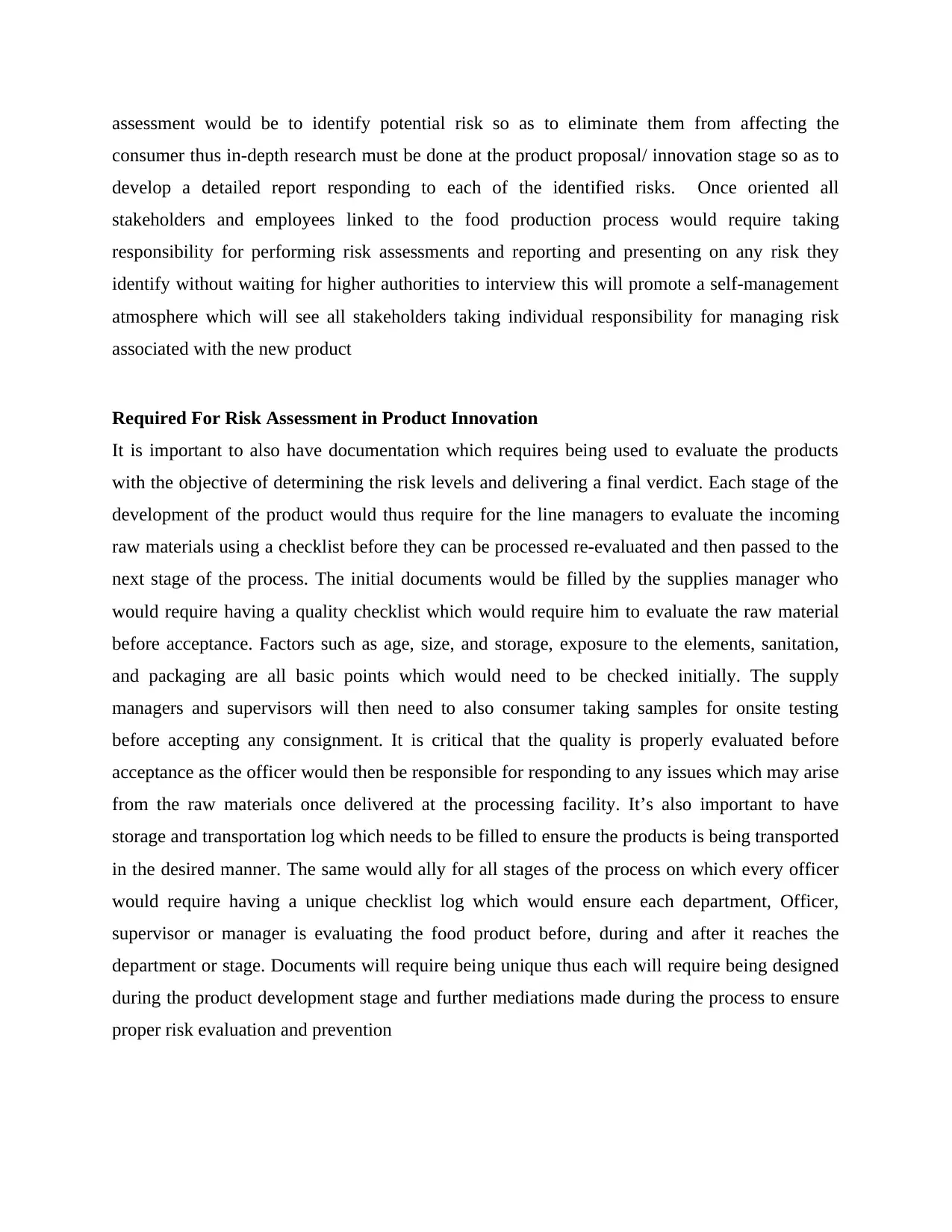
assessment would be to identify potential risk so as to eliminate them from affecting the
consumer thus in-depth research must be done at the product proposal/ innovation stage so as to
develop a detailed report responding to each of the identified risks. Once oriented all
stakeholders and employees linked to the food production process would require taking
responsibility for performing risk assessments and reporting and presenting on any risk they
identify without waiting for higher authorities to interview this will promote a self-management
atmosphere which will see all stakeholders taking individual responsibility for managing risk
associated with the new product
Required For Risk Assessment in Product Innovation
It is important to also have documentation which requires being used to evaluate the products
with the objective of determining the risk levels and delivering a final verdict. Each stage of the
development of the product would thus require for the line managers to evaluate the incoming
raw materials using a checklist before they can be processed re-evaluated and then passed to the
next stage of the process. The initial documents would be filled by the supplies manager who
would require having a quality checklist which would require him to evaluate the raw material
before acceptance. Factors such as age, size, and storage, exposure to the elements, sanitation,
and packaging are all basic points which would need to be checked initially. The supply
managers and supervisors will then need to also consumer taking samples for onsite testing
before accepting any consignment. It is critical that the quality is properly evaluated before
acceptance as the officer would then be responsible for responding to any issues which may arise
from the raw materials once delivered at the processing facility. It’s also important to have
storage and transportation log which needs to be filled to ensure the products is being transported
in the desired manner. The same would ally for all stages of the process on which every officer
would require having a unique checklist log which would ensure each department, Officer,
supervisor or manager is evaluating the food product before, during and after it reaches the
department or stage. Documents will require being unique thus each will require being designed
during the product development stage and further mediations made during the process to ensure
proper risk evaluation and prevention
consumer thus in-depth research must be done at the product proposal/ innovation stage so as to
develop a detailed report responding to each of the identified risks. Once oriented all
stakeholders and employees linked to the food production process would require taking
responsibility for performing risk assessments and reporting and presenting on any risk they
identify without waiting for higher authorities to interview this will promote a self-management
atmosphere which will see all stakeholders taking individual responsibility for managing risk
associated with the new product
Required For Risk Assessment in Product Innovation
It is important to also have documentation which requires being used to evaluate the products
with the objective of determining the risk levels and delivering a final verdict. Each stage of the
development of the product would thus require for the line managers to evaluate the incoming
raw materials using a checklist before they can be processed re-evaluated and then passed to the
next stage of the process. The initial documents would be filled by the supplies manager who
would require having a quality checklist which would require him to evaluate the raw material
before acceptance. Factors such as age, size, and storage, exposure to the elements, sanitation,
and packaging are all basic points which would need to be checked initially. The supply
managers and supervisors will then need to also consumer taking samples for onsite testing
before accepting any consignment. It is critical that the quality is properly evaluated before
acceptance as the officer would then be responsible for responding to any issues which may arise
from the raw materials once delivered at the processing facility. It’s also important to have
storage and transportation log which needs to be filled to ensure the products is being transported
in the desired manner. The same would ally for all stages of the process on which every officer
would require having a unique checklist log which would ensure each department, Officer,
supervisor or manager is evaluating the food product before, during and after it reaches the
department or stage. Documents will require being unique thus each will require being designed
during the product development stage and further mediations made during the process to ensure
proper risk evaluation and prevention
⊘ This is a preview!⊘
Do you want full access?
Subscribe today to unlock all pages.

Trusted by 1+ million students worldwide
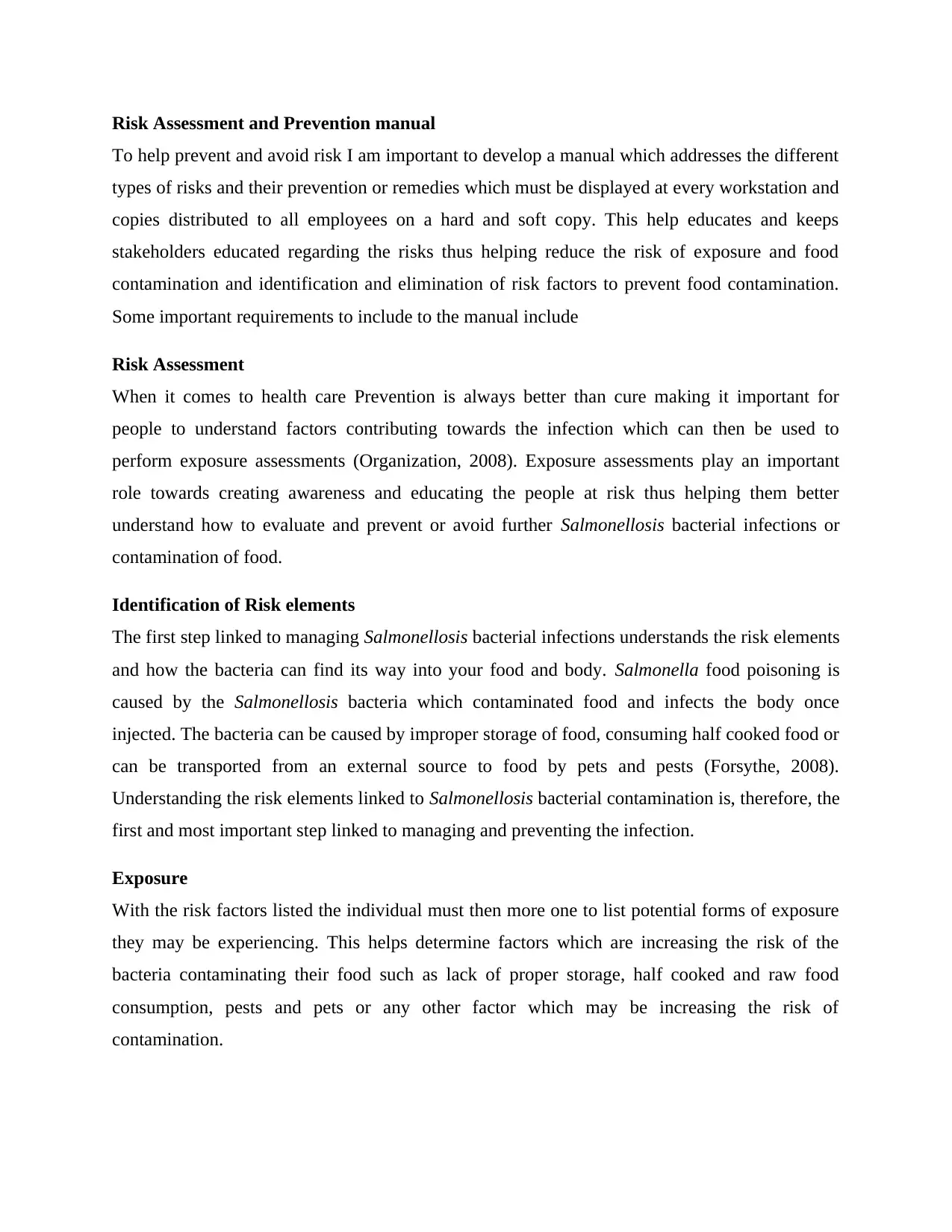
Risk Assessment and Prevention manual
To help prevent and avoid risk I am important to develop a manual which addresses the different
types of risks and their prevention or remedies which must be displayed at every workstation and
copies distributed to all employees on a hard and soft copy. This help educates and keeps
stakeholders educated regarding the risks thus helping reduce the risk of exposure and food
contamination and identification and elimination of risk factors to prevent food contamination.
Some important requirements to include to the manual include
Risk Assessment
When it comes to health care Prevention is always better than cure making it important for
people to understand factors contributing towards the infection which can then be used to
perform exposure assessments (Organization, 2008). Exposure assessments play an important
role towards creating awareness and educating the people at risk thus helping them better
understand how to evaluate and prevent or avoid further Salmonellosis bacterial infections or
contamination of food.
Identification of Risk elements
The first step linked to managing Salmonellosis bacterial infections understands the risk elements
and how the bacteria can find its way into your food and body. Salmonella food poisoning is
caused by the Salmonellosis bacteria which contaminated food and infects the body once
injected. The bacteria can be caused by improper storage of food, consuming half cooked food or
can be transported from an external source to food by pets and pests (Forsythe, 2008).
Understanding the risk elements linked to Salmonellosis bacterial contamination is, therefore, the
first and most important step linked to managing and preventing the infection.
Exposure
With the risk factors listed the individual must then more one to list potential forms of exposure
they may be experiencing. This helps determine factors which are increasing the risk of the
bacteria contaminating their food such as lack of proper storage, half cooked and raw food
consumption, pests and pets or any other factor which may be increasing the risk of
contamination.
To help prevent and avoid risk I am important to develop a manual which addresses the different
types of risks and their prevention or remedies which must be displayed at every workstation and
copies distributed to all employees on a hard and soft copy. This help educates and keeps
stakeholders educated regarding the risks thus helping reduce the risk of exposure and food
contamination and identification and elimination of risk factors to prevent food contamination.
Some important requirements to include to the manual include
Risk Assessment
When it comes to health care Prevention is always better than cure making it important for
people to understand factors contributing towards the infection which can then be used to
perform exposure assessments (Organization, 2008). Exposure assessments play an important
role towards creating awareness and educating the people at risk thus helping them better
understand how to evaluate and prevent or avoid further Salmonellosis bacterial infections or
contamination of food.
Identification of Risk elements
The first step linked to managing Salmonellosis bacterial infections understands the risk elements
and how the bacteria can find its way into your food and body. Salmonella food poisoning is
caused by the Salmonellosis bacteria which contaminated food and infects the body once
injected. The bacteria can be caused by improper storage of food, consuming half cooked food or
can be transported from an external source to food by pets and pests (Forsythe, 2008).
Understanding the risk elements linked to Salmonellosis bacterial contamination is, therefore, the
first and most important step linked to managing and preventing the infection.
Exposure
With the risk factors listed the individual must then more one to list potential forms of exposure
they may be experiencing. This helps determine factors which are increasing the risk of the
bacteria contaminating their food such as lack of proper storage, half cooked and raw food
consumption, pests and pets or any other factor which may be increasing the risk of
contamination.
Paraphrase This Document
Need a fresh take? Get an instant paraphrase of this document with our AI Paraphraser
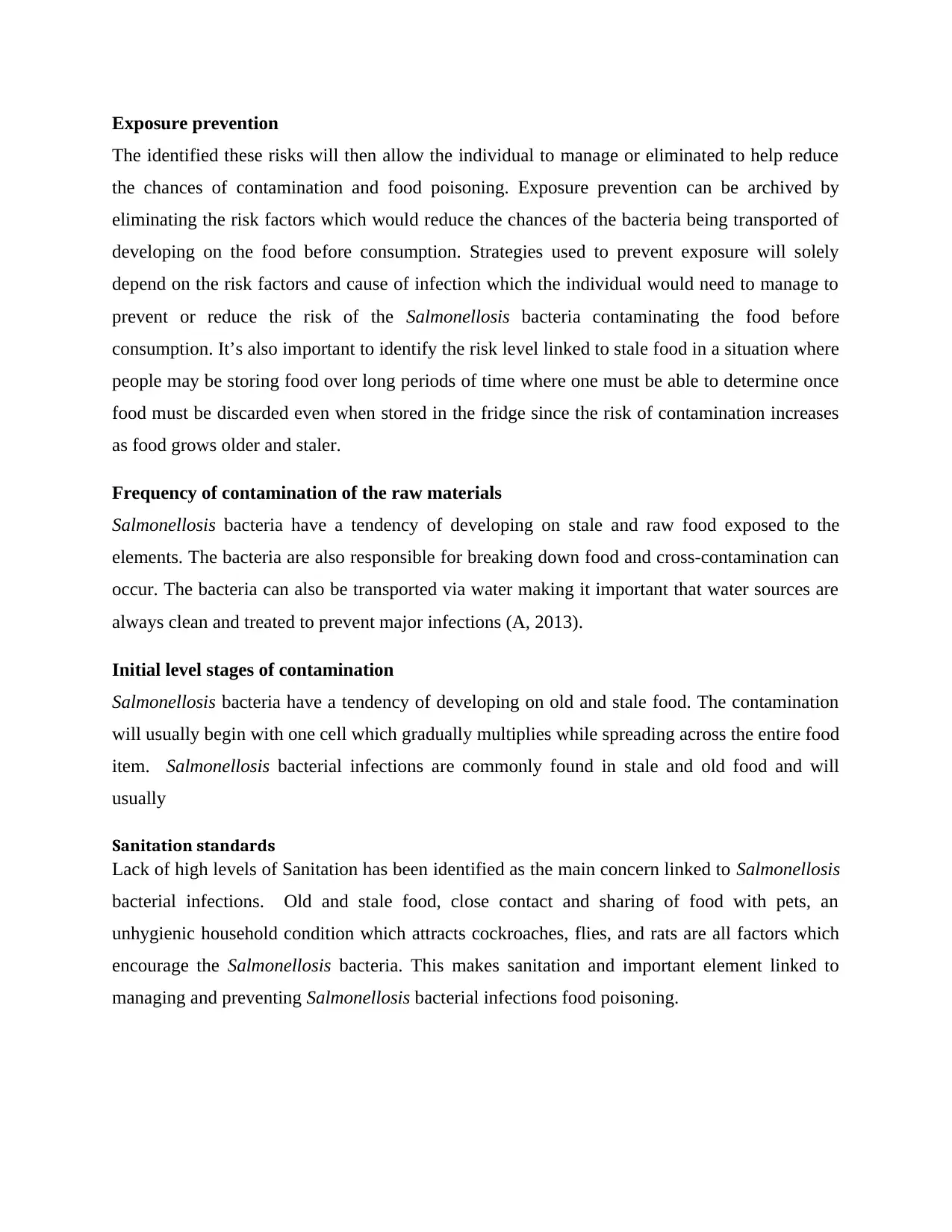
Exposure prevention
The identified these risks will then allow the individual to manage or eliminated to help reduce
the chances of contamination and food poisoning. Exposure prevention can be archived by
eliminating the risk factors which would reduce the chances of the bacteria being transported of
developing on the food before consumption. Strategies used to prevent exposure will solely
depend on the risk factors and cause of infection which the individual would need to manage to
prevent or reduce the risk of the Salmonellosis bacteria contaminating the food before
consumption. It’s also important to identify the risk level linked to stale food in a situation where
people may be storing food over long periods of time where one must be able to determine once
food must be discarded even when stored in the fridge since the risk of contamination increases
as food grows older and staler.
Frequency of contamination of the raw materials
Salmonellosis bacteria have a tendency of developing on stale and raw food exposed to the
elements. The bacteria are also responsible for breaking down food and cross-contamination can
occur. The bacteria can also be transported via water making it important that water sources are
always clean and treated to prevent major infections (A, 2013).
Initial level stages of contamination
Salmonellosis bacteria have a tendency of developing on old and stale food. The contamination
will usually begin with one cell which gradually multiplies while spreading across the entire food
item. Salmonellosis bacterial infections are commonly found in stale and old food and will
usually
Sanitation standards
Lack of high levels of Sanitation has been identified as the main concern linked to Salmonellosis
bacterial infections. Old and stale food, close contact and sharing of food with pets, an
unhygienic household condition which attracts cockroaches, flies, and rats are all factors which
encourage the Salmonellosis bacteria. This makes sanitation and important element linked to
managing and preventing Salmonellosis bacterial infections food poisoning.
The identified these risks will then allow the individual to manage or eliminated to help reduce
the chances of contamination and food poisoning. Exposure prevention can be archived by
eliminating the risk factors which would reduce the chances of the bacteria being transported of
developing on the food before consumption. Strategies used to prevent exposure will solely
depend on the risk factors and cause of infection which the individual would need to manage to
prevent or reduce the risk of the Salmonellosis bacteria contaminating the food before
consumption. It’s also important to identify the risk level linked to stale food in a situation where
people may be storing food over long periods of time where one must be able to determine once
food must be discarded even when stored in the fridge since the risk of contamination increases
as food grows older and staler.
Frequency of contamination of the raw materials
Salmonellosis bacteria have a tendency of developing on stale and raw food exposed to the
elements. The bacteria are also responsible for breaking down food and cross-contamination can
occur. The bacteria can also be transported via water making it important that water sources are
always clean and treated to prevent major infections (A, 2013).
Initial level stages of contamination
Salmonellosis bacteria have a tendency of developing on old and stale food. The contamination
will usually begin with one cell which gradually multiplies while spreading across the entire food
item. Salmonellosis bacterial infections are commonly found in stale and old food and will
usually
Sanitation standards
Lack of high levels of Sanitation has been identified as the main concern linked to Salmonellosis
bacterial infections. Old and stale food, close contact and sharing of food with pets, an
unhygienic household condition which attracts cockroaches, flies, and rats are all factors which
encourage the Salmonellosis bacteria. This makes sanitation and important element linked to
managing and preventing Salmonellosis bacterial infections food poisoning.
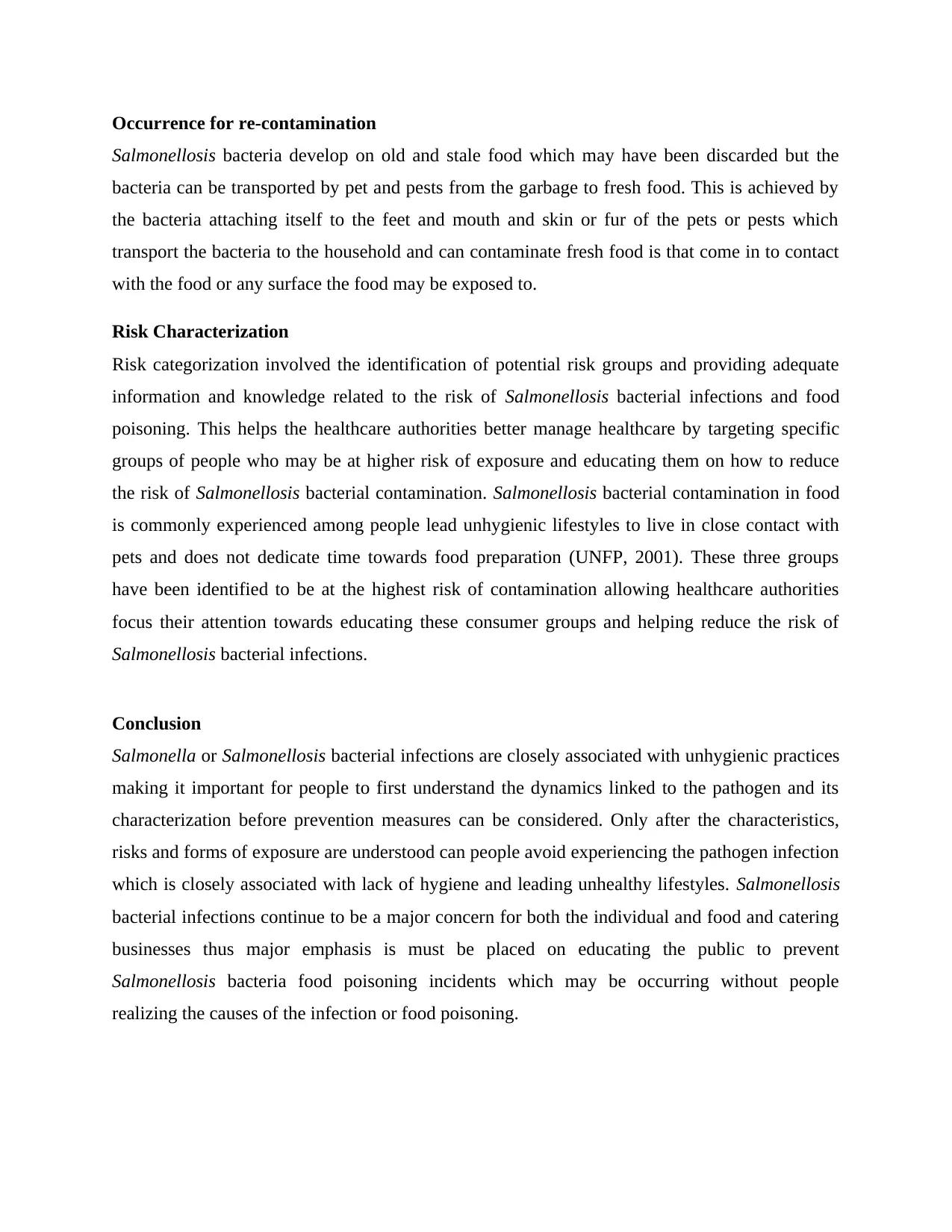
Occurrence for re-contamination
Salmonellosis bacteria develop on old and stale food which may have been discarded but the
bacteria can be transported by pet and pests from the garbage to fresh food. This is achieved by
the bacteria attaching itself to the feet and mouth and skin or fur of the pets or pests which
transport the bacteria to the household and can contaminate fresh food is that come in to contact
with the food or any surface the food may be exposed to.
Risk Characterization
Risk categorization involved the identification of potential risk groups and providing adequate
information and knowledge related to the risk of Salmonellosis bacterial infections and food
poisoning. This helps the healthcare authorities better manage healthcare by targeting specific
groups of people who may be at higher risk of exposure and educating them on how to reduce
the risk of Salmonellosis bacterial contamination. Salmonellosis bacterial contamination in food
is commonly experienced among people lead unhygienic lifestyles to live in close contact with
pets and does not dedicate time towards food preparation (UNFP, 2001). These three groups
have been identified to be at the highest risk of contamination allowing healthcare authorities
focus their attention towards educating these consumer groups and helping reduce the risk of
Salmonellosis bacterial infections.
Conclusion
Salmonella or Salmonellosis bacterial infections are closely associated with unhygienic practices
making it important for people to first understand the dynamics linked to the pathogen and its
characterization before prevention measures can be considered. Only after the characteristics,
risks and forms of exposure are understood can people avoid experiencing the pathogen infection
which is closely associated with lack of hygiene and leading unhealthy lifestyles. Salmonellosis
bacterial infections continue to be a major concern for both the individual and food and catering
businesses thus major emphasis is must be placed on educating the public to prevent
Salmonellosis bacteria food poisoning incidents which may be occurring without people
realizing the causes of the infection or food poisoning.
Salmonellosis bacteria develop on old and stale food which may have been discarded but the
bacteria can be transported by pet and pests from the garbage to fresh food. This is achieved by
the bacteria attaching itself to the feet and mouth and skin or fur of the pets or pests which
transport the bacteria to the household and can contaminate fresh food is that come in to contact
with the food or any surface the food may be exposed to.
Risk Characterization
Risk categorization involved the identification of potential risk groups and providing adequate
information and knowledge related to the risk of Salmonellosis bacterial infections and food
poisoning. This helps the healthcare authorities better manage healthcare by targeting specific
groups of people who may be at higher risk of exposure and educating them on how to reduce
the risk of Salmonellosis bacterial contamination. Salmonellosis bacterial contamination in food
is commonly experienced among people lead unhygienic lifestyles to live in close contact with
pets and does not dedicate time towards food preparation (UNFP, 2001). These three groups
have been identified to be at the highest risk of contamination allowing healthcare authorities
focus their attention towards educating these consumer groups and helping reduce the risk of
Salmonellosis bacterial infections.
Conclusion
Salmonella or Salmonellosis bacterial infections are closely associated with unhygienic practices
making it important for people to first understand the dynamics linked to the pathogen and its
characterization before prevention measures can be considered. Only after the characteristics,
risks and forms of exposure are understood can people avoid experiencing the pathogen infection
which is closely associated with lack of hygiene and leading unhealthy lifestyles. Salmonellosis
bacterial infections continue to be a major concern for both the individual and food and catering
businesses thus major emphasis is must be placed on educating the public to prevent
Salmonellosis bacteria food poisoning incidents which may be occurring without people
realizing the causes of the infection or food poisoning.
⊘ This is a preview!⊘
Do you want full access?
Subscribe today to unlock all pages.

Trusted by 1+ million students worldwide
1 out of 14
Related Documents
Your All-in-One AI-Powered Toolkit for Academic Success.
+13062052269
info@desklib.com
Available 24*7 on WhatsApp / Email
![[object Object]](/_next/static/media/star-bottom.7253800d.svg)
Unlock your academic potential
Copyright © 2020–2025 A2Z Services. All Rights Reserved. Developed and managed by ZUCOL.





